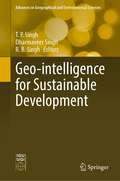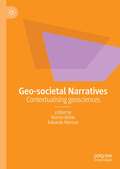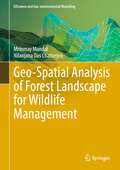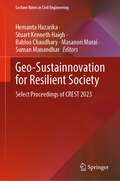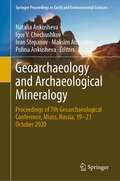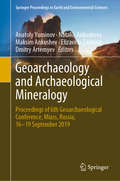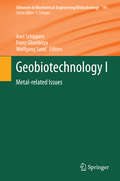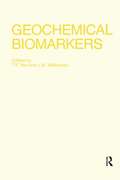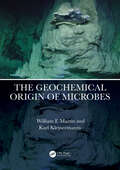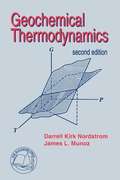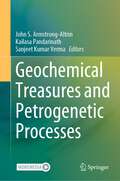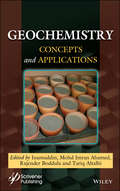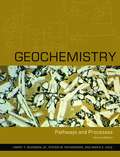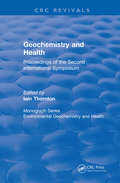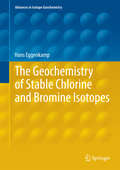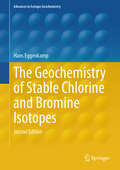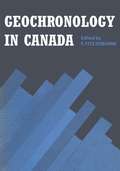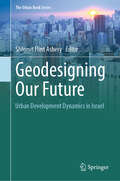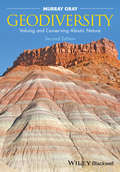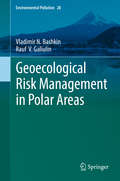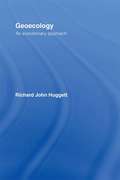- Table View
- List View
Geo-intelligence for Sustainable Development (Advances in Geographical and Environmental Sciences)
by T. P. Singh Dharmaveer Singh R. B. SinghGlobally, concerns for the environment and human well-being have increased as results of threats imposed by climate change and disasters, environmental degradation, pollution of natural resources, water scarcity and proliferation of slums. Finding appropriate solutions to these threats and challenges is not simple, as these are generally complex and require state-of-the-art technology to collect, measure, handle and analyse large volumes of varying data sets. However, the recent advances in sensor technology, coupled with the rapid development of computational power, have greatly enhanced our abilities to capture, store and analyse the surrounding physical environment. This book explores diverse dimensions of geo-intelligence (GI) technology in developing a computing framework for location-based, data-integrating earth observation and predictive modelling to address these issues at all levels and scales. The book provides insight into the applications of GI technology in several fields of spatial and social sciences and attempts to bridge the gap between them.
Geo-societal Narratives: Contextualising geosciences
by Martin Bohle Eduardo MaroneThis book provides an accessible overview of the societal relevance of contemporary geosciences. Engaging various disciplines from humanities and social sciences, the book offers philosophical, cultural, economic, and geoscientific insights into how to contextualise geosciences in the node of Culture and Nature.The authors introduce two perspectives of societal geosciences, both informed by the lens of geoethics. Throughout the text core themes are explored; human agency, the integrity of place, geo-centricity, economy and climate justice, subjective sense-making and spirituality, nationalism, participatory empowerment and leadership in times of anthropogenic global change. The book concludes with a discussion on culture, education, or philosophy of science as aggregating concepts of seemingly disjunct narratives.The diverse intellectual homes of the authors offer a rich resource in terms of how they perceive human agency within the Earth system. Two geoscientific perspectives and fourteen narratives from various cultural, social and political viewpoints contextualise geosciences in the World(s) of the Anthropocene.
Geo-Spatial Analysis of Forest Landscape for Wildlife Management (GIScience and Geo-environmental Modelling)
by Mrinmay Mandal Nilanjana Das ChatterjeeThis book presents research on landscape ecology and the relationship between humans and wildlife. It helps readers understand how ecological patterns and processes are interconnected. This research illustrates and proposes (practicable) management strategies toward long-term ecological restoration and mitigation of consequences of conflict. Increasing wildlife activities in localities and forest fringes are an alarming issue. Ecological processes like movement, colonization, extinction and conflict issues depend on the landscape and ecological activities, the movement for example of migratory elephants and their colonization not only affects society but the wildlife and biodiversity too. Strategic management measures can contribute to enriching the biodiversity, habitat quality as well as landscape, while minimizing human-wildlife conflicts. This book describes landscape ecological patterns and processes, habitat dominancy, habitat dependency, suitability, connectivity and corridor selection. To synthesize these patterns and processes, several ecological indices are used. Use of geo-spatial techniques improves future management strategies for similar circumstances, especially, related to forest regeneration and forest restoration. This book provides a concise overview to a wide range of readers including postgraduate students, researcher, academics, landscape planners, decision makers and even local populations. The techniques and management strategies described should help planners to improve forest management, by implementing quality enhancement programs such as plantation area selection and corridor selection.
Geo-Sustainnovation for Resilient Society: Select Proceedings of CREST 2023 (Lecture Notes in Civil Engineering #446)
by Hemanta Hazarika Stuart Kenneth Haigh Babloo Chaudhary Masanori Murai Suman ManandharThis book presents select proceedings of the 2nd International Conference on Construction Resources for Environmentally Sustainable Technologies (CREST 2023), and focuses on sustainability, promotion of new ideas and innovations in design, construction and maintenance of geotechnical structures with the aim of contributing towards climate change adaptation and disaster resiliency to meet the UN Sustainable Development Goals (SDGs). It presents latest research, information, technological advancement, practical challenges encountered, and solutions adopted in the field of geotechnical engineering for sustainable infrastructure towards climate change adaptation. This volume will be of interest to those in academia and industry alike.
Geoarchaeology and Archaeological Mineralogy: Proceedings of 7th Geoarchaeological Conference, Miass, Russia, 19–23 October 2020 (Springer Proceedings in Earth and Environmental Sciences)
by Natalia Ankusheva Maksim Ankushev Igor V. Chechushkov Ivan Stepanov Polina AnkushevaThis book of Springer Proceedings in Geoarchaeology and Archaeological Mineralogy contains selected papers presented at the 7th Geoarchaeology Conference, which took place during October 19–23, 2020, at the South Urals Federal Research Center, Ural Branch of Russian Academy of Sciences, Miass, Russia. The Proceedings combine studies in archeometry, geoarchaeology, and ancient North Eurasian technologies, including paleometallurgy, stone tools investigation, past exploitation of geological resources, bioarchaeology, residue analysis, pottery, and lithics studies. This book also specializes in various non-organic materials, rocks, minerals, ores, and metals, especially copper and metallurgical slags. Many types of research also use modern analytical methods of isotopic, chemical, and mineralogical analysis to address the composition and structure of ancient materials and the technological practices of past human populations of modern Russia, Ukraine, Turkmenistan, Tajikistan, and Mongolia. This book is intended for archaeologists, historians, museum workers, and geologists, as well as students, researchers from other disciplines, and the general public interested in the interdisciplinary research in the field of archaeology and archaeological materials, strategies and techniques of past quarrying, mining, metallurgy and lithic technologies at different chronological periods in Eurasian steppe and adjacent forest zone.
Geoarchaeology and Archaeological Mineralogy: Proceedings of 6th Geoarchaeological Conference, Miass, Russia, 16-19 September 2019 (Springer Proceedings In Earth And Environmental Sciences)
by Anatoly Yuminov Natalia Ankusheva Maksim Ankushev Elizaveta Zaykova Dmitry ArtemyevThis book presents general problems in geoarchaeology, and discusses geophysical solutions, X-ray fluorescence spectrometry applications, X-ray and isotope analyses and GIS technologies. It also examines practical reconstructions of technological processes used in ancient time, and investigates the use of minerals and rocks by ancient societies in the territories of modern Russia, Ukraine, Turkmenistan, and Tajikistan, as well as the characteristics of ores, metallurgical slags and data on the composition and impurities of archaeological metals. Intended for archaeologists, historians, museum workers and geologists studying noble metals and copper, the book is also a useful resource for students, graduate students, experts and anyone interested in the use of various minerals at different stages of humanity’s development.
Geobiotechnology II
by Wolfgang Sand Franz Glombitza Axel SchippersThis book review series presents current trends in modern biotechnology. The aim is to cover all aspects of this interdisciplinary technology where knowledge, methods and expertise are required from chemistry, biochemistry, microbiology, genetics, chemical engineering and computer science. Volumes are organized topically and provide a comprehensive discussion of developments in the respective field over the past 3-5 years. The series also discusses new discoveries and applications. Special volumes are dedicated to selected topics which focus on new biotechnological products and new processes for their synthesis and purification. In general, special volumes are edited by well-known guest editors. The series editor and publisher will however always be pleased to receive suggestions and supplementary information. Manuscripts are accepted in English.
Geochemical Biomarkers
by T.F. Yen J.M. MoldowanFirst Published in 1988. Routledge is an imprint of Taylor & Francis, an informa company.
The Geochemical Origin of Microbes
by William F. Martin Karl KleinermannsThis is a textbook covering the transition from energy releasing reactions on the early Earth to energy releasing reactions that fueled growth in the first microbial cells. It is for teachers and college students with an interest in microbiology, geosciences, biochemistry, evolution, or all of the above. The scope of the book is a quantum departure from existing “origin of life” books in that it starts with basic chemistry and links energy-releasing geochemical processes to the reactions of microbial metabolism. The text reaches across disciplines, providing students of the geosciences an origins/biology interface and bringing a geochemistry/origins interface to students of microbiology and evolution. Beginning with physical chemistry and transitioning across metabolic networks into microbiology, the timeline documents chemical events and organizational states in hydrothermal vents – the only environments known that bridge the gap between spontaneous chemical reactions that we can still observe in nature today and the physiology of microbes that live from H2, CO2, ammonia, phosphorus, inorganic salts and water. Life is a chemical reaction. What it is and how it arose are two sides of the same coin.Key Features Provides clear connections between geochemical reactions and microbial metabolism Focuses on chemical mechanisms and transition metals Richly illustrated with color figures explaining reactions and processes Covers the origin of the Earth, the origin of metabolism, the origin of protein synthesis and genetic information as well as the escape into the wild of the first free-living cells: Bacteria and Archaea
Geochemical Rate Models
by J. Donald RimstidtThis well-organised, comprehensive reference and textbook describes rate models developed from fundamental kinetic theory and presents models using consistent terminology and notation. Major topics include rate equations, reactor theory, transition state theory, surface reactivity, advective and diffusive transport, aggregation kinetics, nucleation kinetics and solid-solid transformation rates. The theoretical basis and mathematical derivation of each model is presented in detail and illustrated with worked examples from real-world applications to geochemical problems. The book is also supported by online resources: self-study problems put students' new learning into practice, and spreadsheets provide the full data used in figures and examples, enabling students to manipulate the data for themselves. This is an ideal overview for graduate students, providing a solid understanding of geochemical kinetics. It will also provide researchers and professional geochemists with a valuable reference for solving scientific and engineering problems.
Geochemical Thermodynamics
by Darrell Kirk Nordstron James L. MunozGeochemical Thermodynamics (Second Edition), first published in 1994, takes the reader beyond the fundamental principles of thermodynamics to true geochemical applications. You will find the most complete coverage of the phase rule, chemography, solid solutions, ionic activities in the mixed aqueous electrolytes, and chemical potential diagrams for multiphase systems, plus other concepts central to geochemical theory. Throughout, there is an emphasis on environmentally relevant examples and applications. New sections include: - thermobarometry applications for igneous and metamorphic rocks; -expanding information on electrolytes at high temperature and pressure; - a new chapter on geochemical modeling; and substantially updated and expanded references. - a new appendix containing internally consistent enthalpies, entropies, heat capacities, and free energies, and equilibrium constants for a limited number of elements, ions, non-silicate minerals, and reactions at 298. 15K and 1 atmosphere that are particularly useful for hydrogeochemical modeling. 'This book presents the thermodynamics of geochemical systems, with applications ranging from groundwater to magmas. It should be of interest to a large number of such scientists wishing better acquaintance with the application of thermodynamics to practical problems. Geology There is a good balance of theory and application, and the book is superior to any other available text at the graduate or undergraduate level I can strongly recommend this book, having used it for a third-year undergraduate geochemistry course. It is most appropriate for physical geochemistry course with an emphases on thermodynamics. Researchers in petrology oriented fields will also find the book useful Canadian Mineralogist
Geochemical Treasures and Petrogenetic Processes
by John S. Armstrong-Altrin Kailasa Pandarinath Sanjeet Kumar VermaThis book highlights various aspects of geochemical and geological processes. In brief, it facilitates to understand the geochemical behavior of major, trace and rare earth elements in rocks to identify the magmatic processes involved in present-day magma generation and their relation to global tectonic regimes as well as geothermal studies. Therefore, the book provides a comprehensive view of the generation of magma types (mafic to felsic in composition) and their role in the petrogenesis. The book also covers the development of new geosoftware to effectively process the geochemical data before its interpretation.
Geochemistry: Concepts and Applications
by Inamuddin, Mohd Imran Ahamed Rajender Boddula Tariq AltalhiThis book aims to explore basic principles, concepts and applications of geochemistry. Topics include chemical weathering, impacts on living beings and water, geochemical cycles, oxidation and redox reactions in geochemistry, isotopes, analytical techniques, medicinal, inorganic, marine, atmospheric, and environmental applications, as well as case studies. This book helps in understanding the chemical composition of the earth and its applications. It also includes beneficial effects, bottlenecks, solutions, and future directions in geochemistry.
Geochemistry: Pathways and Processes
by Harry McSween Steven Richardson Maria UhleWritten expressly for undergraduate and graduate geologists, this book focuses on how geochemical principles can be used to solve practical problems. The attention to problem-solving reflects the authors'belief that showing how theory is useful in solving real-life problems is vital for learning. The book gives students a thorough grasp of the basic principles of the subject, balancing the traditional equilibrium perspective and the kinetic viewpoint. The first half of the book considers processes in which temperature and pressure are nearly constant. After introductions to the laws of thermodynamics, to fundamental equations for flow and diffusion, and to solution chemistry, these principles are used to investigate diagenesis, weathering, and natural waters. The second half of the book applies thermodynamics and kinetics to systems undergoing changes in temperature and pressure during magmatism and metamorphism. This revised edition incorporates new geochemical discoveries as examples of processes and pathways, with new chapters on mineral structure and bonding and on organic matter and biomarkers. Each chapter has worked problems, and the authors assume that the student has had a year of college-level chemistry and a year of calculus.Praise for the first edition"A truly modern geochemistry book.... Very well written and quite enjoyable to read.... An excellent basic text for graduate level instruction in geochemistry." —Journal of Geological Education"An up-to-date, broadly conceived introduction to geochemistry.... Given the recent flowering of geochemistry as an interdisciplinary science, and given the extent to which it now draws upon the fundamentals of thermodynamics and kinetics to understand earth and planetary processes, this timely and rigorous [book] is welcome indeed." —Geochimica et Cosmochimica Acta
Geochemistry and Health: Proceedings of the Second International Symposium (CRC Press Revivals)
by J.N. MartinThis volume comprises the proceedings of a three-day meeting held at the Royal Society, London, UK on 22,23,24 April 1987. The combined second International Symposium on Geochemistry and Health and 5th European Meeting of the Society for Environmental Geochemistry and Health was sponsored by the International Association of Geochemistry and Cosmochemistry, UMESCO, the Society for Environmental Geochemistry and Health and Imperial College with additional finacial supposrt from the UK Department of the Environment, the Royal Society, London and the Southern California Edison Company.
The Geochemistry of Stable Chlorine and Bromine Isotopes
by Hans EggenkampThis book provides detailed information on the history, analysis and applications of chlorine and bromine isotope geochemistry. Chlorine and bromine are geochemically unique as they prefer to exist as single charged negative ions. For this reason isotope fractionation reflects mostly processes that are not related to changes in the redox state and this fractionation is generally modest. The book will describe the processes that are most easily detected using these isotopes. Also isotope variations, and processes that cause them, measured in oxidised species such as perchlorates and in organic molecules will be described in this book.
The Geochemistry of Stable Chlorine and Bromine Isotopes (Advances in Isotope Geochemistry)
by Hans EggenkampThis book provides detailed information on the history, analysis and applications of chlorine and bromine isotope geochemistry. Chlorine and bromine are geochemically unique as they prefer to exist as single charged negative ions. For this reason isotope fractionation reflects mostly processes that are not related to changes in the redox state and this fractionation is generally modest. The book will describe the processes that are most easily detected using these isotopes. Also isotope variations, and processes that cause them, measured in oxidised species such as perchlorates and in organic molecules will be described in this book.
The Geochemistry of Stable Chlorine and Bromine Isotopes (Advances in Isotope Geochemistry)
by Hans EggenkampThis book provides detailed information on the history, analysis and applications of chlorine and bromine isotope geochemistry. This largely extended 2nd edition has incorporated most research published between 2014 and 2023, and contains also significantly more information on the earliest experimental data obtained during the early 20th century. This 2nd edition describes isotope studies done on terrestrial samples, and also incorporates the fascinating chlorine (and bromine) isotope ratio investigations obtained from extraterrestrial and astronomical studies, and thus it shows the full extent of the current status of knowledge of this subject.
Geochronology in Canada (The Royal Society of Canada Special Publications #No. 8)
by Freleigh OsborneThis volume is made up of papers presented at a colloquium of the Geology Devision of Section III of the Royal Society of Canada at the annual meeting in Quebec, June 1963. The papers fall into two groups: in one group the validity and shortcomings of the methods of establishing the geographical time-table are discussed; and, in the other, applications of the methods to areas across Canada, and from Precambrian to recent, are described. The geological time-table has been built up from the record of the rocks and is based on the law of superposition, a fact that is pointed out in the first paper of this volume. The chronological value of fossils, palaeomagnetism as a means of dating geological events, the limitations of radiometric dating, and other pertinent matters are here dealth with by a group of well-known authorities. These scientific disquisitions will be of great importance to geologists everywhere.This work should be of special interest to those engaged in research on the history of the earth, particularly in relation to the nature, the causes, and the time of an event. It will also serve as a valuable reference to practising geologists in government or industry, to university departments of geology, and to geological consultants. Royal Society of Canada, "Special Publications" Series, no. 8.
Geodesigning Our Future: Urban Development Dynamics in Israel (The Urban Book Series)
by Shlomit Flint AsheryThis book examines how map-based collaboration software can facilitate negotiations in areas undergoing contentious pressures for significant change. Based on case studies from Israel, it aims to introduce a useful model of planning implementation as an outcome of complex interaction to reduce the gap between planning and urban reality. It puts an analytical realist foundation for a productive discussion of the role of future planning and bares meaningful scientific contributions to the general frame of the negotiating process and implementation, which still needs further research and elaboration.Geodesign, a cutting-edge planning approach that is rooted in the history of planning practice, has become one of the most popular approaches for sustainable planning and design activities after 2000s. Planners tend to think of design at a site scale, but geodesign covers a variety of scales, bridging the gap between the regional and the local contexts.This is important because to be practically effective and politically prudent, "smart growth" plans need to make sense across a spectrum of scales and disciplines. This ranges from design, urban design, community planning, town and city planning, and regional planning, up to planning for mega-regions.
Geodiversity
by Murray GrayThe first book to focus exclusively on the subject, Geodiversity, Second Edition describes the interrelationships between geodiversity and biodiversity, the value of geodiversity to society, as well as current threats to its existence. Illustrated with global case studies throughout, the book examines traditional approaches to protecting geodiversity and the new management agenda now being implemented. The Second Edition of this successful textbook continues to build on the success of the first edition which is still the standard reference for the subject.Fully revised and updated throughout, the Second Edition now includes new material on geoparks, geotourism and implications of climate change for geoconservation.Reviews of previous edition:"Murray Gray's new book is the first widely available text to bring together and analyse some of these emerging ideas....The result is a book that should be in the library of every land manager and one that is likely to lead many practicing geoscientists and quaternarists to a new view of the importance of their field for nature conservation and environmental management... (Journal of Quaternary Science, Vol.19, No.8, December 2004) "It is strange that it is necessary to justify the importance of geodiversity.... Murray Gray does it with brilliance, not only to convince 'non-believers', but giving inspiration to us that have worked in geoconservation for a long time" (ProGEO News, 3 & 4, 2003) "...The author provides a timely review of recent advances in the integration of geodiversity into wider conservation and planning strategies..." ...." (Journal of Quaternary Science, Vol.19, No.8, December 2004) "...the book is well-written and follows a clear and concise outline." (Environmental Geology, Vol. 48, No. 2, July 2005)
Geoecological Risk Management in Polar Areas (Environmental Pollution #28)
by Vladimir N. Bashkin Rauf V. GaliulinThis monograph is devoted to full-scale geoecological risk assessment in gas industry impacted polar areas and the relevant risk management options using innovative nature-like biogeochemical technologies. Readers will discover more about geoecological risks during gas production, transportation, storage and refining. Chapters discuss in detail the geodynamic dangers associated with the designing and building of main gas pipelines. The book has interdisciplinary appeal, and specialists and practitioners in environmental sciences, ecology, biogeochemistry and those within the energy sector who are interested in understanding ecosystems affected by anthropogenic impacts in severe climatic conditions will find it particularly engaging. Through this book, readers will learn more about recultivation of contaminated soils as well as health risk assessments of chemical substances associated with the gas industry.
Geoecology: An Evolutionary Approach
by Richard HuggettAnimals, plants and soils interact with one another, with the terrestrial spheres, and with the rest of the Cosmos. On land, this rich interaction creates landscape systems or geoecosystems. Geoecology investigates the structure and function of geoecosystems, their components and their environment. The author develops a simple dynamic systems model, the `brash' equation, to form the conceptual framework for the book suggesting an `ecological' and `evolutionary' approach. Exploring internal of `ecological' interactions between geoecosystems and their near-surface environments - the atmosphere, hydrosphere, toposhere, and lithosphere - and external influences, both geological and cosmic, Geoecology presents geoecosystems as dynamic entities constantly responding to changes within themselves and their surroundings. An `evolutionary' view emerges of geoecological systems, and the animals, plants, and soils comprising them, providing a new way of thinking for the whole environmental complex and the rich web of interdependencies contained therein.
Geoecology of Landscape Dynamics (Advances in Geographical and Environmental Sciences)
by R. B. Singh Manish Kumar Seema SahdevThis book provides an overview of the ecological indicators of landscape dynamics in the context of geographical landscape integration. Landscape dynamics depicts every change that occurs in the physical, biological, and cognitive assets of a landscape. To understand and interpret the complex physical, biological, and cognitive phenomena of landscapes, it is necessary to operate conceptually and practically on a broad range of spatial and temporal scales. Rapid land use changes have become a concern to environmentalists and planners because of their impacts on the natural ecosystem, which further determines socioeconomic dynamics. In this regard, the book discusses case studies that share new insights into how landscape patterns and processes impact small creatures, and how small creatures in turn influence landscape structure and composition. In turn, the relevant aspects of land use and land cover dynamics are covered, and the multi-faceted relationship between the substrata and ecological community is highlighted. The book is unique in its focus on the application of spatial informatics such as automatic building extraction from high-resolution imagery; a soil resource inventory for meeting the challenges of land degradation; hydrological modeling; the temporal variation analysis of glacier area and the identification and mapping of glacial lakes; morphometric analysis of river basins; and the monitoring and modeling of urban sprawl, among other features.
Geoenergy Modeling II
by Haibing Shao Philipp Hein Agnes Sachse Olaf KolditzThis book is dedicated to the numerical modeling of shallow geothermal systems. The utilization of shallow geothermal energy involves the integration of multiple Borehole Heat Exchangers (BHE) with Ground Source Heat Pump (GSHP) systems to provide heating and cooling. The modeling practices explained in this book can improve the efficiency of these increasingly common systems. The book begins by explaining the basic theory of heat transport processes in man-made as well as natural media. . These techniques are then applied to the simulation of borehole heat exchangers and their interaction with the surrounding soil. The numerical and analytical models are verified against analytical solutions and measured data from a Thermal Response Test, and finally, a real test site is analyzed through the model and discussed with regard to BHE and GSHP system design and optimization.
